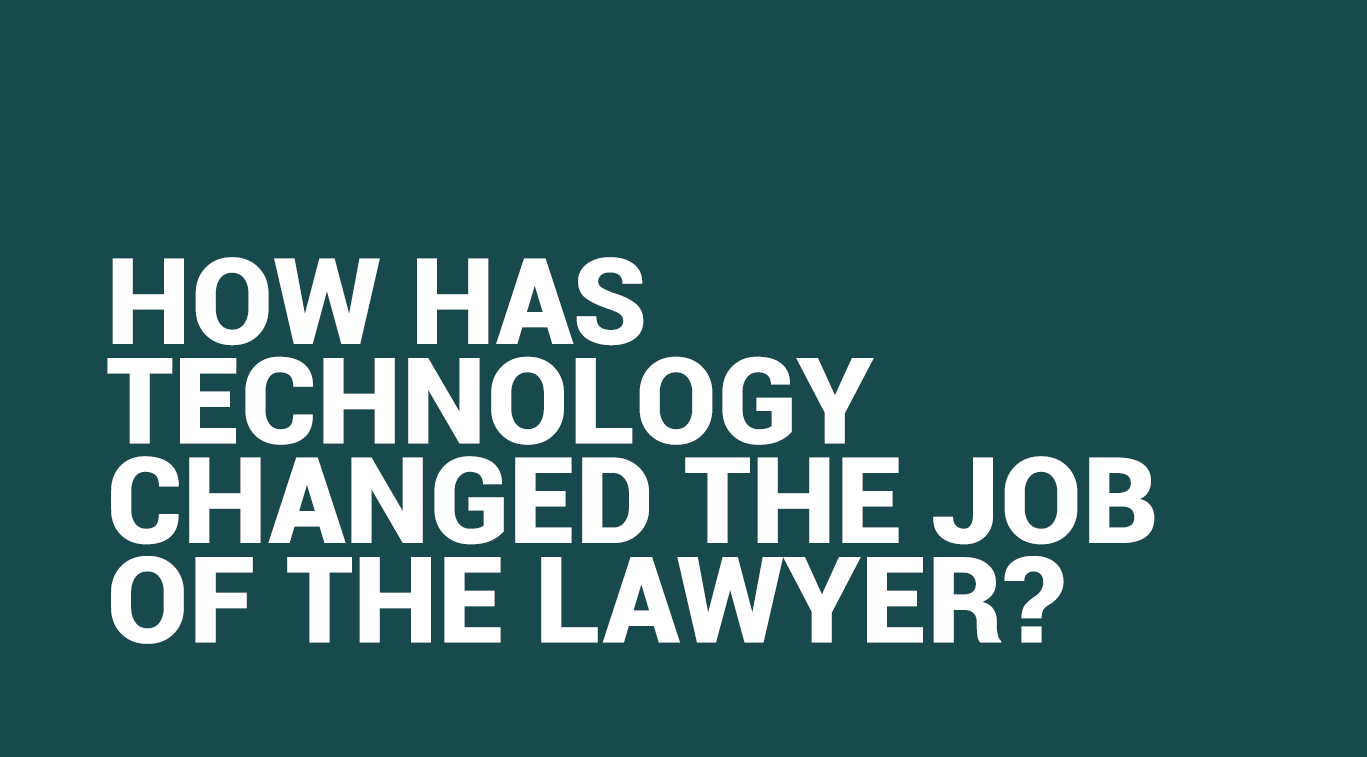How has automation transformed the way the Legal Industry works?

Written by Shrisha Sapkota
Blogger

There was a time when the term “automation” was synonymous with advanced manufacturing plants full of robotics.[1] Automation is everywhere these days.[2] Skill shifts have accompanied the introduction of new technologies in the workplace since at least the Industrial Revolution, but the adoption of automation and artificial intelligence (AI) will mark an acceleration over the shifts of even the recent past.[3] Technology and automation are changing everyday tasks to make our lives even easier such as driverless cars, or Google Glass beaming public transport updates to your eyes.[4]
Automation is a broad concept that applies to modern workplaces in more ways than the obvious.[5] It is a term for technology applications where human input is minimised which includes business process automation (BPA), IT automation, personal applications such as home automation, and more.[6] The implementation of these technologies, techniques, and processes improves the efficiency, reliability, and/or speed of many tasks that were previously performed by humans.[7]
There is much debate about where workplace automation will lead the economy, but observers tend to agree that the trend is gaining momentum.[8] It is everywhere, and its penetration and sophistication are increasing.[9]
Workplace automation is widely available, often taking the form of software tools in commonly used programs.[10] It is being used in many areas such as manufacturing, transport, utilities, defence, facilities, operations, and lately, information technology.[11] Every business process is on the table for automation, especially as technology becomes more sophisticated.[12]
From contactless cashiers to welding drones to “chow bots” — machines that serve up salads on-demand — automation is fundamentally transforming, rather than merely touching, every aspect of daily life, and this prospect may well please consumers.[13] Beyond traditional industrial automation and advanced robots, new generations of more capable autonomous systems are appearing in environments ranging from autonomous vehicles on roads to automated check-outs in the grocery store.[14]
Automation can also increase scale and speed – for example, Nissan has halved the time it takes to move from final product design to production thanks to an automated system, while BMW has reduced machine downtime by 30 to 40 percent—effectively generating fresh economies of scale with minimal investment—through AI-enabled condition-based maintenance.[15] Much of this progress has been driven by improvements in systems and components, including mechanics, sensors, and software.[16]
Automation can improve safety and security. In a factory setting, for example, robots are taking over dangerous jobs involving blades, welding, chemical exposure – among other things and it’s obvious why human error can have huge consequences in this setting, especially after workers have been on the line for long hours.[17] Research shows automation can reduce three out of the five leading causes of workplace injuries, including contact with harmful objects, heavy lifting, and repetitive stress injuries.[18]
One-third of all jobs could be automated in the next decade.[19] It will undoubtedly change the workplace and the wider economy – the only question is: to what extent?[20] The technology could create millions more jobs than it displaces.[21]
The labour market impact of technology is often viewed through the lens of job creation or job destruction.[22] While replacing human labour with machine labour is a prime example of workplace automation, it’s far from the only example.[23] If technology displaces workers, jobs are lost and if technology creates (or reinstates) work, jobs are created.[24] A major question here is whether automation creates jobs or destroys them. New technologies have the potential to create new jobs.[25] The World Economic Forum estimates that by 2025, technology will create at least 12 million more jobs than it destroys, a sign that in the long run, automation will be a net positive for society.[26]
However, job creation alone is not enough. Just as significant is how much money employees can make by doing these jobs. Do technological advancements cause wages to increase or drop? Although economists frequently discuss whether automation generates or eliminates employment, they pay less attention to how it transforms jobs and the salaries paid to the individuals who perform them.
Contrary to common belief about robots and automated machines stealing people’s jobs, the future isn’t likely to become wholly automated. Instead, it’s more likely that we’ll enter a future where people work alongside robots.[27]
Automation won’t replace people, but it will free them from performing mundane and repetitive tasks.[28] By automating repetitive business processes, employees are freed up for tasks that are more valuable than those that can be completed by machines.[29] Work should be about the creative, collaborative, sometimes messy but often enjoyable tasks that are part of our job but we find our days are spent working on a never-ending list of manual and mundane tasks which slows us down and expending our energy on these low-value activities can lead to mistakes when we do make it to the tasks that matter.[30] With automation, machines will be able to carry out more of the tasks done by humans, complement the work that humans do, and even perform some tasks that go beyond what humans can do.[31] Forsaking human folly for algorithmic (and mechanistic) perfection means better, cheaper, and faster service.[32]
The Covid-19 pandemic has accelerated the adoption of cutting-edge technologies[33] at work which includes automation. Since everyone was forced to stay indoors, companies and businesses suffered from all of their work and projects pausing for the time being. So, a good ratio of them quickly switched lanes from making their employees manually complete work to asking everyone to work from home and start using electronic/technological tools which would make their job swifter. As the pandemic starts to settle, people are going back to the jobs they were doing before it happened – with some updates. But for many people, the job they used to do might not be coming back – and increasingly, as employers battle with the challenges of the pandemic, this could be due to automation.[34] But what should workers — who once provided these services — expect? Can they also benefit from technological progress? If so, how?[35]
Even as machines take over several organisational tasks, many new tasks will emerge that can only be conducted by people.[36] Workers will spend more time on activities that machines are less capable of, such as managing people, applying expertise, and communicating with others.[37] We may also be better at weighing offsetting factors and making final calls in complex and unique situations.[38]
We will spend less time on predictable physical activities, and on collecting and processing data, where machines already exceed human performance.[39] Processes can become slicker and more accurate while giving people back the time to work on what they do best and what they love.[40]
Humans are likely to hold the edge for a while in other areas.[41] The skills and capabilities required will shift, requiring more social and emotional skills, and more advanced cognitive capabilities, such as logical reasoning and creativity – and we will have to adapt accordingly.[42] The human body, with its hands and fingers, and thumbs, is a multifaceted work platform, and flexibility and adaptability are likely to remain key human advantages.[43]
Also, despite advances in automation, some manual intervention is always advised, even if the tool can perform most of the tasks.[44] Robots are unlikely to become managers because of the need to evaluate and make decisions based on a host of factors.[45] Automation professionals involved in the creation, application, and monitoring of such technologies are in high demand.[46]
Done right, automation can free up human workers to provide more of that kind of experience.[47]
Automation may have a massive influence on how businesses operate in the future, so employers and employees need to keep an open mind to the benefits, as they could offer more creativity and take away mundane tasks.[48] It is present in modern businesses of all sizes – including subtle features in common software applications, and more obvious implementations like self-driving vehicles or autonomous robots.[49] As we look to the year ahead and beyond, it’s time to embrace the potential of work automation.[50] The automation debate isn’t going to go away, but personnel concerns can be addressed if businesses are open and honest about the future – even if they’re unsure themselves.[51]
Automation and the Legal Industry
The legal industry is one of the oldest and most traditional professions out there, and has tended to keep its traditional way of thinking meaning the adoption of automation and artificial intelligence in the legal sector has been fairly slow.[52] Nevertheless, companies are evolving quickly during this time of crisis – after everything took a hit due to the Covid-19 pandemic – which has only increased the need for legal workflow automation software.[53]
Legal firms have to deal with a large volume of repetitive, routine tasks which they must complete due to the requirements of due diligence even though the time this requires could be better spent on engaging new clients.[54] That is why making use of artificial intelligence (AI) in the legal sector a part of your contract management process is crucial.[55]
Advances in legal tech provide law firms with various advanced legal solutions such as e-billing, e-signature, dashboards, workflow automation tools, and general compliance.[56] One example of this is e-discovery algorithms that lawyers and law firms have been using for a long time to locate and gain access to files and documents on a case or relevant to it. The algorithm which falls under legal technology solutions is much swifter at finding these documents. The software is accurate, too — it finds 95 percent of relevant documents, compared to just 51 percent for humans.[57] These solutions have become the major adoption for the legal industry as the use of technology stacks and application integration picks up momentum.[58]
Perhaps the most time-consuming responsibility for legal teams is the management and manual review of contracts and related documents.[59] Using the best legal document automation software can be beneficial to reduce time and costs, particularly when the most common method of charging used by law firms is by the hour.[60] With a controlled negotiation cycle, a common approval workflow, and an industry-standard, integrated electronic signature system, more specifically, it can reduce pressure on the legal department and they are able to focus on more strategic matters.[61]
Leveraging these tools for law strategically can more effectively help analyse the risk of taking on a new client and cut the cost of managing civil cases within FRC guidelines.[62] Firms can save time and money on this and use it to expand – there’s still plenty of work for paralegals to do.[63]
Another one of the many benefits of contract automation is that legal teams can have unlimited access to contracts which enables them to work anytime and anywhere.[64] Legal software solutions can also automatically perform periodic due-diligence checks and flag dubious activity with 24-hour vigilance and 100 percent accuracy.[65] Keeping up with these compliance checks before or after a trial can help firms to protect themselves against sanctions and fines.
Due to automation, firms can also offer clients a more efficient and cost-effective service, and provide them with a seamless and collaborative experience with their business which not only puts them in a more competitive position within the industry but also will aid in increasing the firm’s retention rates in the future.[66]
The extent to which automation transforms the economy at large remains to be seen, but it appears inevitable that we’re headed toward a future of more automation.[67] There is work for everyone today and there will be work for everyone tomorrow, even in a future with automation but that work will be different, requiring new skills, and far greater adaptability of the workforce than we have seen.[68] What this means for businesses, workers and consumers will be the subject of huge debate moving forward but one thing seems certain, however: If it can be automated, it will be.[69]
The adoption of automation and AI in the legal sector shows innovation within the company and the ability to adapt to the modern world.[70] Thus, adapting to an automation-first approach will undeniably revolutionise the way the legal sector performs.[71] Law organisations should change their strategies to fuse automation in their everyday functions.[72]
References
[1] https://www.businessnewsdaily.com/9835-automation-tech-workforce.html
[2] https://hbr.org/2021/11/automation-doesnt-just-create-or-destroy-jobs-it-transforms-them
[3]https://www.mckinsey.com/featured-insights/future-of-work/skill-shift-automation-and-the-future-of-the-workforce
[4] https://www.sodexoengage.com/blog/technology-and-automation-in-the-workplace
[5] https://www.businessnewsdaily.com/9835-automation-tech-workforce.html
[6] https://www.ibm.com/topics/automation
[7] https://www.techopedia.com/definition/32099/automation
[8] https://www.businessnewsdaily.com/9835-automation-tech-workforce.html
[9] https://www.shrm.org/hr-today/news/all-things-work/pages/the-automation-revolution.aspx
[10] https://www.businessnewsdaily.com/9835-automation-tech-workforce.html
[11] https://www.techopedia.com/definition/32099/automation
[12] https://www.businessnewsdaily.com/9835-automation-tech-workforce.html
[13] https://hbr.org/2021/11/automation-doesnt-just-create-or-destroy-jobs-it-transforms-them
[14]https://www.mckinsey.com/featured-insights/future-of-work/ai-automation-and-the-future-of-work-ten-things-to-solve-for
[15]https://www.mckinsey.com/~/media/mckinsey/industries/public%20and%20social%20sector/our%2
0insights/what%20the%20future%20of%20work%20will%20mean%20for%20jobs%20skills%20and%20w
ages/mgi%20jobs%20lost-jobs%20gained_report_december%202017.pdf
[16]https://www.mckinsey.com/featured-insights/future-of-work/ai-automation-and-the-future-of-work-ten-things-to-solve-for
[17] https://medium.com/@meetsally/5-positive-benefits-of-automation-in-the-workplace-8501823cf4af
[18] https://www.apecusa.com/blog/8-benefits-of-automation-for-businesses-and-employees/
[19] https://www.weforum.org/agenda/2020/09/short-history-jobs-automation/
[20] https://www.businessnewsdaily.com/9835-automation-tech-workforce.html
[21] https://www.weforum.org/agenda/2020/09/short-history-jobs-automation/
[22] https://hbr.org/2021/11/automation-doesnt-just-create-or-destroy-jobs-it-transforms-them
[23] https://www.businessnewsdaily.com/9835-automation-tech-workforce.html
[24] https://hbr.org/2021/11/automation-doesnt-just-create-or-destroy-jobs-it-transforms-them
[25] https://dobetter.esade.edu/en/automation-jobs?_wrapper_format=html
[26] https://hbr.org/2021/11/automation-doesnt-just-create-or-destroy-jobs-it-transforms-them
[27]https://www.forbes.com/sites/forbestechcouncil/2020/05/01/the-benefits-of-automation-in-todays-workforce/?sh=7756c1d51cc8
[28] https://www.businessnewsdaily.com/9835-automation-tech-workforce.html
[29] https://www.businessnewsdaily.com/9835-automation-tech-workforce.html
[30]https://www.information-age.com/how-automation-powering-work-transformation-five-examples-123498668/
[31]https://www.mckinsey.com/featured-insights/future-of-work/ai-automation-and-the-future-of-work-ten-things-to-solve-for
[32] https://hbr.org/2021/11/automation-doesnt-just-create-or-destroy-jobs-it-transforms-them
[33] https://hbr.org/2021/11/automation-doesnt-just-create-or-destroy-jobs-it-transforms-them
[34] https://www.weforum.org/agenda/2020/09/short-history-jobs-automation/
[35] https://hbr.org/2021/11/automation-doesnt-just-create-or-destroy-jobs-it-transforms-them
[36]https://www.tcs.com/perspectives/articles/the-crucial-role-of-people-in-a-world-of-extreme-automation
[37]https://www.mckinsey.com/~/media/mckinsey/industries/public%20and%20social%20sector/our%2
0insights/what%20the%20future%20of%20work%20will%20mean%20for%20jobs%20skills%20and%20w
ages/mgi%20jobs%20lost-jobs%20gained_report_december%202017.pdf
[38] https://www.shrm.org/hr-today/news/all-things-work/pages/the-automation-revolution.aspx
[39]https://www.mckinsey.com/~/media/mckinsey/industries/public%20and%20social%20sector/our%2
0insights/what%20the%20future%20of%20work%20will%20mean%20for%20jobs%20skills%20and%20w
ages/mgi%20jobs%20lost-jobs%20gained_report_december%202017.pdf
[40]https://www.information-age.com/how-automation-powering-work-transformation-five-examples-123498668/
[41] https://www.shrm.org/hr-today/news/all-things-work/pages/the-automation-revolution.aspx
[42]https://www.mckinsey.com/~/media/mckinsey/industries/public%20and%20social%20sector/our%2
0insights/what%20the%20future%20of%20work%20will%20mean%20for%20jobs%20skills%20and%20w
ages/mgi%20jobs%20lost-jobs%20gained_report_december%202017.pdf
[43] https://www.shrm.org/hr-today/news/all-things-work/pages/the-automation-revolution.aspx
[44] https://www.techopedia.com/definition/32099/automation
[45] https://www.shrm.org/hr-today/news/all-things-work/pages/the-automation-revolution.aspx
[46] https://www.techopedia.com/definition/32099/automation
[47] https://www.shrm.org/hr-today/news/all-things-work/pages/the-automation-revolution.aspx
[48] https://www.sodexoengage.com/blog/technology-and-automation-in-the-workplace
[49] https://www.businessnewsdaily.com/9835-automation-tech-workforce.html
[50]https://www.information-age.com/how-automation-powering-work-transformation-five-examples-123498668/
[51] https://www.sodexoengage.com/blog/technology-and-automation-in-the-workplace
[52]https://www.workwithglee.com/blog/2022/02/how-automation-and-ai-are-transforming-the-legal-sector
[53]https://www.lawyer-monthly.com/2021/12/how-ai-and-automation-are-transforming-legal-teams/#:~:text=With%20such%20automation%2C%20legal%20teams,to%20a%20total%20value%20cent
re.
[54] https://www.anyrobot.com/blog/automation-in-the-legal-sector
[55]https://www.lawyer-monthly.com/2021/12/how-ai-and-automation-are-transforming-legal-teams/#:~:text=With%20such%20automation%2C%20legal%20teams,to%20a%20total%20value%20cent
re.
[56] https://industrywired.com/how-robotic-process-automation-can-transform-legal-sector/
[57] https://www.ricoh-usa.com/en/insights/articles/why-job-automation-is-a-good-thing
[58] https://industrywired.com/how-robotic-process-automation-can-transform-legal-sector/
[59]https://www.lawyer-monthly.com/2021/12/how-ai-and-automation-are-transforming-legal-teams/#:~:text=With%20such%20automation%2C%20legal%20teams,to%20a%20total%20value%20cent
re.
[60] https://industrywired.com/how-robotic-process-automation-can-transform-legal-sector/
[61]https://www.lawyer-monthly.com/2021/12/how-ai-and-automation-are-transforming-legal-teams/#:~:text=With%20such%20automation%2C%20legal%20teams,to%20a%20total%20value%20cent
re.
[62] https://industrywired.com/how-robotic-process-automation-can-transform-legal-sector/
[63] https://www.ricoh-usa.com/en/insights/articles/why-job-automation-is-a-good-thing
[64][64]https://www.lawyer-monthly.com/2021/12/how-ai-and-automation-are-transforming-legal-teams/#:~:text=With%20such%20automation%2C%20legal%20teams,to%20a%20total%20value%20cent
re.
[65] https://industrywired.com/how-robotic-process-automation-can-transform-legal-sector/
[66]https://www.workwithglee.com/blog/2022/02/how-automation-and-ai-are-transforming-the-legal-sector
[67] https://www.businessnewsdaily.com/9835-automation-tech-workforce.html
[68]https://www.mckinsey.com/featured-insights/future-of-work/ai-automation-and-the-future-of-work-ten-things-to-solve-for
[69] https://www.businessnewsdaily.com/9835-automation-tech-workforce.html
[70]https://www.workwithglee.com/blog/2022/02/how-automation-and-ai-are-transforming-the-legal-sector
[71] https://industrywired.com/how-robotic-process-automation-can-transform-legal-sector/
[72] https://www.analyticsinsight.net/intelligent-automation-is-transforming-legal-firms/








